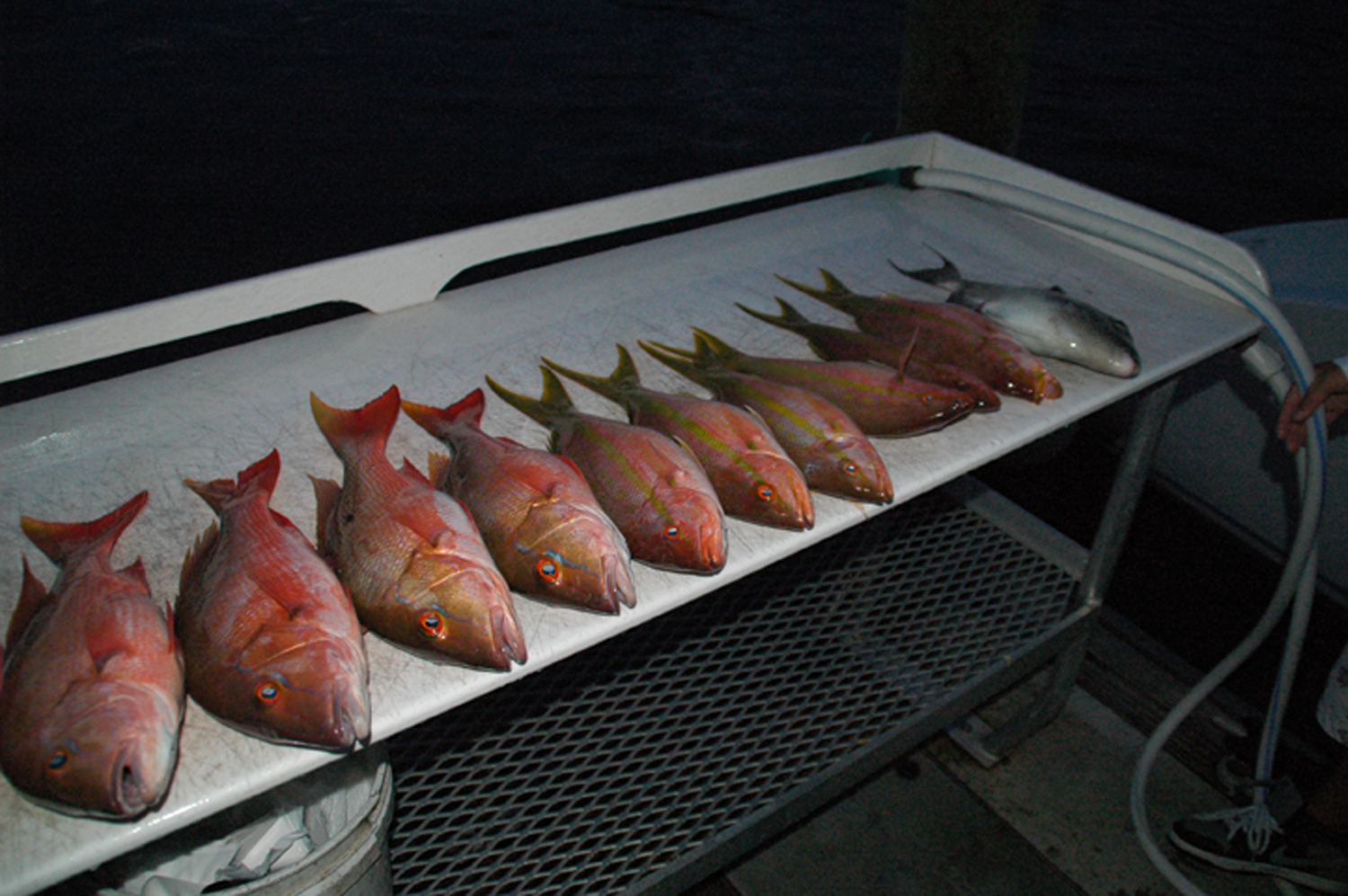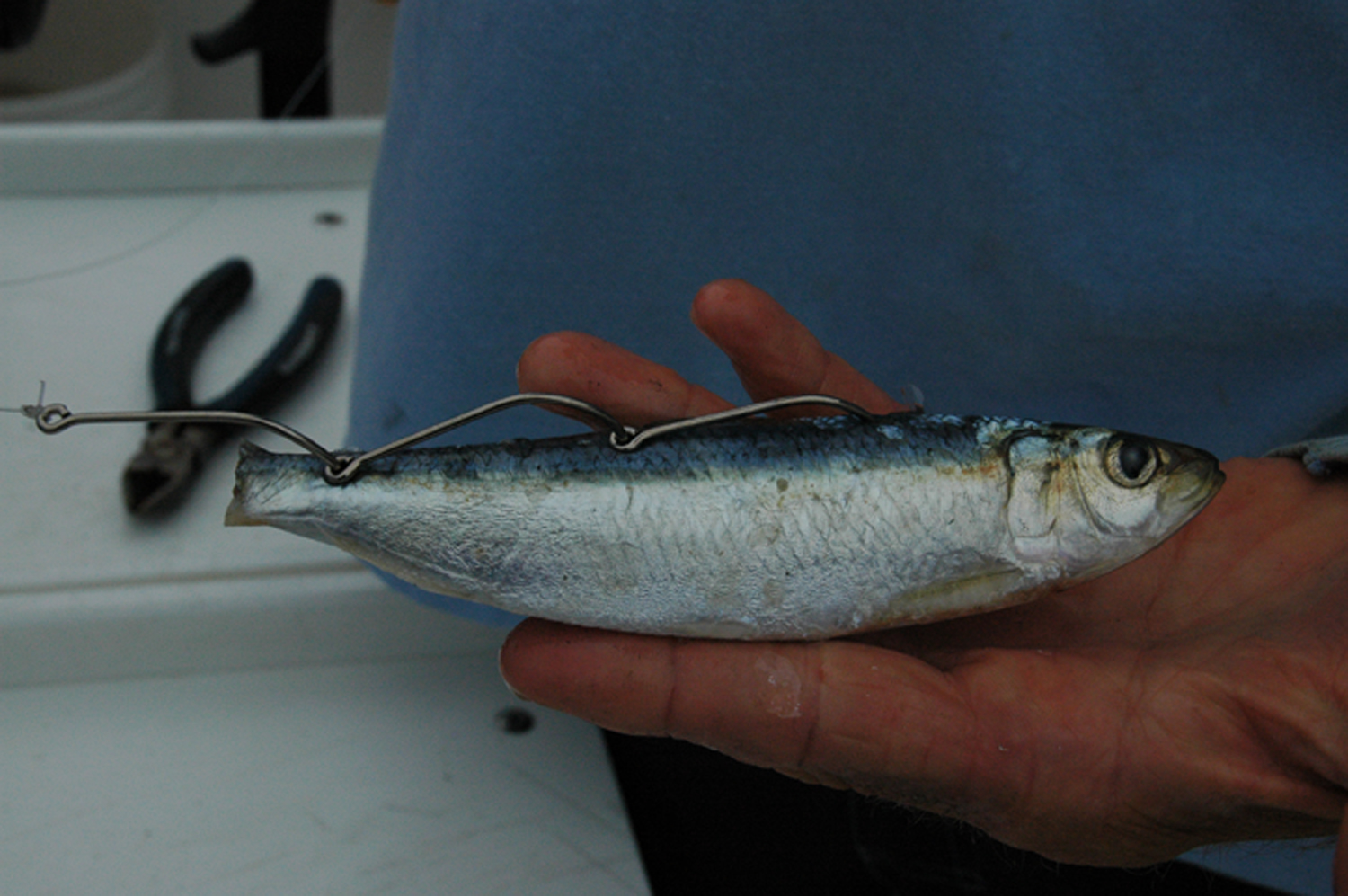October 21, 2011
By Jeff Weakley
Catch good-eating muttons and more beneath the midwater kingfish carnage.
Originally published April 2010.
 A 30-pound kingfish puts a grin on Mark Glore's face.
A 30-pound kingfish puts a grin on Mark Glore's face.
A spring kingfish bite is something to behold. When they're really chewin', you can hardly get a bait down 20 feet without a blistering runoff. Live bait, dead bait, jig—often doesn't matter.
That action alone can make a day, but if you stop for a minute and ask yourself “what else is biting here?” you might bump into some surprising bonus catches.
I'm talking snapper—muttons, yellowtails, lanes, even genuine reds in some districts. Yes, these are fish associated with reefs and other structure. But, these colorful, good-eating fish sometimes hang beneath kingfish schools, picking up scraps of sardines and other forage torn to shreds by the toothy macks.
Last spring eight of us joined an evening trip aboard the Black Dog out of Jupiter. She's a 42-foot driftboat skippered by the affable, knowledgeable Capt. Bill Taylor.
When it comes to producing big kings, Jupiter is up there with the Dry Tortugas and the Louisiana oil fields. It's a unique corner of Florida's eastern continental shelf; south of here, the 20-fathom line runs uniformly parallel to the coastline, within 1 to 2 miles of shore. Warmed by the Gulf Stream, the offshore current seldom dips below 70 degrees, generally accepted as the minimum threshold for kingfish activity. North of Jupiter, the Florida coastline bends away toward the northwest, opening onto an ever-widening shelf, where fluctuating water temps and pulses of estuarine water nourish and move bait schools. It's an ideal mix of deep-ocean and shelf habitat.
What Jupiter has over other geographically-blessed kingfish ports is quick access to the fishing grounds. Taylor's single-diesel converted lobster boat gets on the fish without losing much time to the twin- and triple-outboard mosquito fleet.
Finding the concentration of kings off Jupiter (or anywhere in Florida, for that matter) can be as simple as locating the boats. I was surprised to see how many boats were fishing south of Jupiter Inlet on a late April afternoon. A nasty front was moving across the state, but the regional radar showed a providential hole in the storms passing over Jupiter.
We set up outside the line of boats in about 90 feet of water; some were trolling, while others were drift-fishing.
Taylor paid special attention to his sonar.
 Muttons and yellowtails will be the crowd-pleasers at the dinner table.
Muttons and yellowtails will be the crowd-pleasers at the dinner table.
“Most days we're pretty much fishing structure—ledges, the high bar that runs up through the county,” he said. “But when the kings are in, we switch over. Kings are sloppy eaters. Whether it's sardines, flyingfish or whatnot, they take one bite and let the rest fall to the bottom. Especially in spring and summer, the snappers gather under the kings, and it's like a rain of bait coming down.”
Anticipating fast action, Taylor's mate had flats of frozen sardines and 5-gallon buckets strategically placed near the anglers. He scissored the tails off the baits to reduce spin.
We each had 6- or 7-foot conventional rods with high-speed star drag reels and 30-pound-test monofilament, terminating in 50-pound-test fluorocarbon leaders and triple-hook rigs. Some rigs we had without weight, for freelining kingfish baits, while other rigs we had 1- or 2-ounce egg sinkers sliding to a swivel connecting to the 6-foot leader.
“We use the slide rigs for snapper, as light as you can go; you don't want the fish to feel any more weight than it has to,” Taylor said. “If the water is super clear we might switch to fluorocarbon leader in 30- or 40-pound test.
“Some days if the current is strong we might use up to 5 ounces, on a chicken rig, but one of the nice things about this area is we can move north or south to find conditions to our liking.”
Light wind and light north current made for relatively easy fishing on our trip, and as expected the kings gobbled up more than their share of baits. These were nice fish, 10 to 30 pounds, but with three kings for every keeper mutton or yellowtail, some of us were starting to grumble.
“Not much you can do about that, when the kings are really worked up,” Taylor said.
A surprising proportion of kings made it to the boat, hooked as they were on the aft end of the multi-hook rigs. Taylor figures on losing some kings to leader cutoffs, but the rate at which you get bites on fluoro versus wire keeps you on the positive side of the ledger at day's end. Never mind the fact that wire leader really puts off the keen-eyed snappers.
Sensing his customers growing somewhat bored with the kings, Taylor strategically edged outside of the main kingfish concentration, and that's where we started picking up more mutton and yellowtail snapper.
“Most of our mutton snapper here are 3 or 4 pounds, and we catch a lot of throwbacks (sub 16 inches). But it's been an exceptional bite,” he said.
“Our yellowtail are nice fish, not monsters, but a lot of 2-pounders. Good vermilion snapper fishing, too, sometimes. And we've seen a lot more gag grouper than we have in the past few years. Can we chalk that up to conservation? I hope so.
“We've even started giving some free trips to people willing to throw back big groupers—I'll tell ‘em how important it is to keep the spawn potential there, preserve our fishery so there's something to catch next season. Most of our customers are looking for dinner, and personally I'd rather eat the smaller fish myself.”
The dinner side of things was looking pretty good as we chugged back through Jupiter Inlet in the waning daylight. After divying up the smaller kings (those under 31 inches are by far the best eating), we each had a nice bag of snappers.
Taylor said the action was pretty typical for this time of year. “We always get a shot of kingfish in winter; depending on the fronts, they seem to bounce around the coast, up around Fort Pierce or Canaveral. But the best run starts at the end of April, and runs through May.”
Days later, I thought back on the trip and recalled similar action off Miami, where we always made sure to put a bait all the way on bottom when targeting kings and other pelagic hunters. Some days a fast-sinking bucktail jig of 2 to 6 ounces produced as well as a bait—get the jig close to bottom and work it with quick snaps of the rodtip. Another option was sinking a whole ballyhoo on a jig, casting upcurrent while drifting, letting the combo reach bottom, then unspooling line while drifting.
A curious thing about those snappers—they may just as likely be following the bait as the kingfish.
The so-called Sand Pile off St. Lucie Inlet, north of Jupiter, sees a great mutton bite in summer, and while there may or may not be thick schools of kings nearby, the fish are generally beneath bait schools. Further north on the east coast, fishermen off Mayport at times catch snappers beneath sardine schools in water 60 to 90 feet deep. Up there, on a wide continental shelf composed mostly of sand bottom, any time you run across baitfish dimpling the surface, it's worth a stop. The bait schools may be congregating over an isolated reef, or they may represent a mobile buffet table with a crowd of hungry snappers on their tails.
Find the bait, the kings, or both, and it's always worth a drop.
 A good way to hook a frozen sardine for mixed-bag action during the spring kingfish run.
A good way to hook a frozen sardine for mixed-bag action during the spring kingfish run.
Dead Bait Drift Rig
Captain Bill Taylor uses a triple-hook rig consisting of three Eagle Claw 085 hooks—4/0s for muttons, 6/0s for kingfish.
“You can snap them together, depending on the batch. Sometimes you'll have to open the eye on them a little to get the barb through, but some batches they just pop together.”
The bait, a dead sardine, is hooked backwards to minimize spin.
When the action's really heavy, most any bait will get attention.
“Piece of cutbait works great,” said Taylor. “Under the kings it looks like all the goo that's coming down anyway.”
Lighter, Stronger Rods for Drifting
Some driftboat anglers are converting over to the lightweight, parabolic-action jigging blanks, such as the Shimano Trevala model.
“You get a nice bend in these poles, forgiving for the angler who likes to set up on the fish,” Capt. Bill Taylor explained. “They load up and have plenty of power in them.”
A number of companies, including Star Rods, are expanding the utility for these powerful sticks.
“Basically a thick wall, thin diameter blank,” said Phillip Henry of Seastriker/Star Rods, which this year introduced Paraflex and Plasma series jigging and boat rods. “It's high-density graphite wound on a dowel, but rolled thicker. And Star uses multi-directional epoxy-coated fibers wrapped around the blank. A 50- to 100-pound-class boat rod, for instance, might be identical in size to a traditional 20- to 40-pound rod.”
FS
